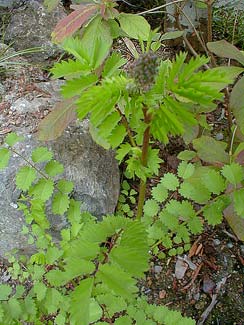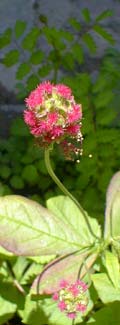
Salad Burnet
"Get up, get up for shame! The blooming morn
Upon her wings presents the god unshorn.
See how Aurora throws her fair
Fresh-quilted colours through the air:
Get up, sweet slug-a-bed, & see
The dew-bespangling herb & tree!"
-Robert Herrick
(1591-1674)
(1591-1674)
Salad Burnet (Poterium sanguisorba, aka Sanguisorba minor) is a hardy perennial with fine ornamental qualities such as ferny leaves & green with pink-tipped ball-flowers in late May & June.
 It is also, as its common name implies, a flavorful herb, the leaves of which have a cucumbery taste, useful in salads, on sandwiches, as a garnish vastly more edible than a sprig of raw parsley, or cooked with any cassarole dish or soup that might call for basil, oregano, or dill.
It is also, as its common name implies, a flavorful herb, the leaves of which have a cucumbery taste, useful in salads, on sandwiches, as a garnish vastly more edible than a sprig of raw parsley, or cooked with any cassarole dish or soup that might call for basil, oregano, or dill.It's quite popularly used in European cuisine, but Americans don't seem as aware of it as a kitchen herb. Elizabethans loved it, & would float the leaves in a glass of wine, because in the poetic language of flowers popular at the time, Salad Burnet indicated a merry mood or ribald gathering.
It is good in yogurt sauces as a replacement for (or in addition to) cucumbers; is an excellent choice for herb vinegar; can replace mint sprigs for iced tea; & is excellent chopped up in dips, cheese spreads, & salad dressings. Sir Frances Bacon planted it along his garden paths because he adored the scent that released when it was trod upon. The leaves & scented flowers can be dried for potpourri.
During the height of summer it becomes harder & more bitter, though not entirely inedible. If it is trimmed back, it will return tender & fresh for autumn use. As it is evergreen, it can provide occasional fresh-harvest even in winter when most other soft herbs have died to the ground.
The Newe Herball published in 1551 lauded Salad Burnet for its supposed medicinal properties, claiming even that it was a cure for bubonic plague. It does have at least an astringent value. The species name sanguisorba or "blood-drink" alludes to its traditional use to stop internal hemorrhaging. Whether it can actually perform this chore is not at all likely; nevertheless, soldiers would drink a tea made from Salad Burnet before going into battle, in the belief that if they were wounded, they would not be so likely to bleed to death.
This European herb has been grown in America since the Pilgrims brought it with them. It was grown by Thomas Jefferson as forage for livestock & to halt erosion. It requires very well drained soil or it may rot from dampness, just outside the edge of shade where it gets a good portion of sun yet with some protection from heat, which it does not like.
The leaves will fountain into a low clump, with the leafed flower stems upright to twenty inches. It will get tall & leggy if the flowers are left to seed, but cut off before the flowers turn, the basal leaves will get flufflier over time, producing increasing numbers of harvestable tender leaves. It will flourish in poor soil & even tolerates alkalinity.